1993 165 cm Brown
Breeder: August Meyer
Stakkato created a sensation at his first appearance at the Bundeschampionate back in 1998. So wonderful was his jumping style that the judges wanted to give him a 10 – until one pointed out that one tiny part of the young stallion’s tongue was visible on one side of his mouth! So they had to settle for a 9.9.
Fourteen years later, Stakkato was proclaimed Hanoverian Stallion of the Year 2000.
Stakkato was born on April 4, 1993 on August Meyer’s farm in Uenzen, Germany. Andreas Mundt raised him and presented him at the stallion licensing in autumn 1995. The jumping lines of Servus and Gotthard are combined in his sire’s pedigree. His dam Pia successfully competed up to elementary show jumping level. At her mare performance test, her jumping skills were judged with the perfect score of 10.
Stakkato showed spectacular free jumping skills at the licensing in Verden so Dr Burchard Bade purchased him for the Celle State Stud. He went on to be the best jumper at his stallion performance test. Stakkato then took the jumping championship at the Bundeschampionate in Warendorf in 1998. At the 1999 Bundeschampionate, he was reserve champion.
Four years later, the bay stallion won the German Championship in the ladies’ division under Eva Bitter. Since then, Stakkato has competed on a number of occasions for the German Nation’s Cup team. One of his best performances was second place at the highly ranked Nörten-Hardenberg Grand Prix of 2007.
Photo: Kiki Beelitz
Do you remember when you first saw Stakkato?
Eva remembers it well: “I surely do, it was at the Hanoverian Stud where he did the stallion licensing test when he was three years old. He was a really nice youngster, he was the first young horse that I ever taught.”
How did you manage to talk the director at the time, Dr Bade, into giving him to you?
“I think it was my trainer, Heinrich Willem Johansman, I was training with him at the time, he talked to Dr Bade, and okay when he was three no-one knew, he was such a superstar, and he was not like a really special breeding stallion… he was a good sport horse, you could see that he was an amazing jumper, but he was a little bit small, not a really big stallion type. This was our chance.”
Eva and Stakkato at Münster – Photo: Jaques Toffi
But did you imagine then that you would be riding sons and grand-sons of this horse?
“No, for sure not, but this is really so nice. I am really proud too of Satisfaction, his son, he is a really special horse. I’ve had many special ones from Stakkato.”
What are the things he gives as a stallion to his progeny?
“It’s really on the inside, they want to do good – I don’t know one Stakkato that doesn’t want to jump, one that is afraid or stopping. When you have a problem it is that they want to do too much, they go too much into the fence, they want to do too much, but this is what he gives to his sons and daughters and grand-sons and grand-daughters. They really want to jump.”
Stakkato’s sire, Spartan
Stakkato comes from an illustrious jumping family – although his sire, Spartan was almost lost to the German breeding industry, having been sold to the United States.
Spartan was discovered by Hans-Joachim Köhler and he was sold as a yearling to Mr and Mrs Himmelmayer of Viriginia, USA.
Spartan returned to Germany and passed his performance test with the impressive jumping index of 130.26 (dressage index – 111.41) and an overall score of 122.31. From 1985 until 1991, Spartan stood in Canada and the US, and competed in jumping classes to Grand Prix level with Sasha Himmelmayer.
He then returned to Germany to stand at Andreas Mundt’s farm in Petershagen, where he was a licensed stallion with the Hanoverian, Oldenburg and Westfalien studbooks. Andreas Mundt was the last Bereiter-apprentice to work with H-J Köhler.
According to Siegfried Putscher: “His children inherited elastic movement, with an energetic push from their hindquarters, excellent rideability, performance willingness as well as a lot of jumping talent and great intelligence. ‘The Spartans learn quickly’, that is what you hear in rider circles.”
Spartan is by Servus (Sesam I/Dominus/Goldfisch II) of the Trakehner Semper Idem line. Servus produced a number of successful jumpers as well as the international dressage competitor, Slivovitz. Spartan’s dam is Gottilde, by the jumping foundation sire, Gotthard, and out of a truly great mare, Steingilde by the Thoroughbred, Steinpilz xx out of S26287, a heavier mare by Elsass, a grandson of Abendsport.
According to Siegfried Putscher in an artcle – Jumping Talents: The Family of Steingilde – in The Hanoverian, 3/2000:
“The dam, the great- and the great-great dam from Steingilde were strongly influenced by largely framed, strong and tough sires of the Adeptus xx line. After a dramatic decline, this line today flourishes again through Eiger I, Espri, Escudo I and II – especially with respect to jumping talent.”
In 1958 Steingilde’s dam, the mare who goes by the numerals, S26287 was born. Her sire was Elsass, a grandson of Abendesport. Elsass was known for producing good mares and Swiss remounts. S26287 was then bred to Steinpilz xx. According to Putscher: “The Thoroughbred Steinpilz xx mostly produced large, tough performance horses with above average jumping ability. His daughter Steingilde was a noble mare with a well set neck, an expressive head, appealing movement and an excellent disposition.”
Steingilde bred to Gotthard produced Gambrinus, sold in the Verden Spring Auction of 1974 to Calgary’s Ron Southern for the then top price of DM25,000. Steingilde produced three full sisters to Gambrinus: Gottilde, Geri and Gilda.
Bred to Absatz, Gottilde produced Argonner Wald, sold at the 1980 Verden spring Auction for DM20,000 to Alwin Schockemöhle. In 1981, as Alwin’s Ass, he was the champion 5 year old showjumper at the Bundeschampionate. Later he competed with Franke Sloothaak and Michael Matz.
Bred to Servus, she produced Spartan, the sire of Stakkato.
Spartan died of a heart attack in March 2000 at the age of 18.
Stakkato is out of Pia by Pygmalion (Patras/Absatz). Pygmalion stood at the Köhler stud in Verden. His sire, Patras was a very noble and strong Trakehner, clearly influenced by Arabian and English Thoroughbred blood. Patras was a controversial stallion in his time, and when the Hanoverians refused to license him, Herr Köhler set up the ZfdP – the Association for the Breeding of German Horses.
Stakkato was the exception to the Celle rule at the time in that the showjumping rider Eva Bitter purchased the competition rights to the stallion, while Celle kept the breeding rights.
While private stallions have increasingly used the spotlight of the competition ring to attract mares, the Stud Director at Celle, Dr Bade was at the time no fan of the policy of taking breeding stallions out into competition. He was worried about the effect on the quality of the semen.
Dr Bade – no fan of breeding stallions, competing
“You will not change a stallion in his heritability by putting him into competition,” he told me. “If you take semen on the Monday and look under the microscope, you can see by the quality of the semen if the horse has been competing at the weekend.”
Luckily Stakkato’s conformation problems and poor type forced Dr Bade to make an exception.
According to Dr Bade: “He is such a type that I think the breeders would say, ‘You can talk of his jumping ability but he is not our type’, but after Eva Bitter competes with him, then the breeders want to use him.”
Stakkato rocketed up the FN rankings for jumping stallions and this provoked some criticism – particularly in the pages of the Zangersheide magazine – which focussed on his high ranking without any performing progeny and compared that with an established sire like Carthago who had already produced competition winners…
In the face of the Stakkato sceptics, it must have given Dr Ludwig Christmann of the Hanoverian Verband great satisfaction to record in his 2007 summation of the ‘hot’ stallions in Hanover, that:
“In the beginning there was undoubtedly scepticism, whether his offspring would be able to fulfil the high expectations set by Stakkato’s high breed values. In the meantime, good quality in his progeny is the proof. 1997 was his first year of breeding. During last year’s show season his oldest descendants were only eight years old. 188 of his offspring are registered as competition horses, 136 successfully competed in jumper riding horse classes and in open jumper classes. Twenty-one of his foals were successful at the most difficult level, which is quite an impressive quota at such a young age. Many of his youngsters are stabled with international competitors, as for instance the mare Rueckenwind, who has a considerable show record in international classes for young horses under her rider Holger Wulschner.”
Dr Jochen Wilkens, the breeding director of the Hanoverian Verband from 1983 to 2006 considers Stakkato the leading jumping stallion of his time:
“Of the last years, Stakkato has been the most important jumping stallion. He is in a special program and is ridden by Eva Bitter – so he is only at the State Stud for a couple of months each year, and he is booked out for that time. The jumping breeders all want him, but I still always say, ‘look at the type of the mare’. I think he is the stallion who has given us most progress in the jumping ability.”
In the past the Hanoverian State Stud stallions did not compete, yet Stakkato is an exception, will this mean that we will see more and more Hanoverian State stallions in the competition arena, like the private stallions?
“I think to find out how good the stallion is, he can go out in the sport in the first few years after the performance test. From the age three to six, it is good to bring them in the sport, but it is not necessary to compete them any more than this, because when you compete the stallion to this age, then you know already what kind of horse he is.”
“With Stakkato, he went to the Bundeschampionate where he was the champion, and this made him very popular especially because of his form over a fence, he always jumped so high above the top rail that people asked, why is this? But this is his way to jump, for some it looks unnatural, but it was, and it still is.”
What qualities does he give to his progeny?
“Especially the jumping ability. For him to breed stallions is a little bit difficult, because the type is important for the stallion licensing, but the breeders now know more and more how to breed with him. It should be a refined mare, then he produces very well.”
At the 2013 Bundeschampionate, Stakkato, was the dominating sire in the 5-year-old class after the first go round. He was the sire of three of the top 25, and in number one spot was his son, Sandokan, out of a Landor S mare, and ridden by Eva Bitter. After the first round, Sandokan, received that traditional Bundeschampionate award, a purchase offer from Paul Schockemöhle, which was, seemingly, accepted.
After the final, Sandokan and Eva Bitter were way out in front with scores of 9.5 and 9.7. His nearest rivals, Congo-Bongo (Cassini Boy Junior / Kigali) and Otmar Eckermann are on 8.8 and 9.2 then follow: Cabana (Carrico / Lord Kemm), Calino (Calico / Corofino), Cornwall (Cornet Obolensky / Contender), Cornet (Celestial / Figaro), Casaltina (Casall / Corrado), Cosby (Contendro I / Landadel) and rounding out the 10, Callum (Casall / Alcatraz).
The 2008 edition of the Hannoveraner Jahrbuch Hengste featured Stakkato on the cover – celebrating his being named Hanoverian stallion of the year for 2007.
The 2021 Hanoverian Stallion book, records Stakkato with a jumping breeding value of 152 and a dressage value of 68. In might be noted that Dr Bade’s forebodings about his appearance, have been borne out in the progeny. On the basis of the Hanoverian mare testing, Stakkato has a negative value of 59 for type, and must have produced some very plain heads for a ‘head value’ of 49 (by way of comparison, Caprimond, who has dominated the Riding Horse Type standings in much the same ways as Stakkato has dominated the Jumping standings, has produced heads with a value of 197 – but then again, his jumping value was just 76.)
Stakkato, who first headed the FN rankings in 2001, was number three on the FN’s 2014 topliste, with a value of 166. In 2021, he has a young jumping horse value of 153, and a highest level achieved value of 145.
Stakkato is listed in the 2021 Hanoverian yearbook with an astonishing 51 licensed sons, and he is credited with 927 competitors, who have earned €3,089,788 (he himself had lifetime earnings of €242,438), with his best performer, Souvenir with earnings of €412,716. Souvenir was a National Champion in 2009 with Phillip Weishaupt and was a regular member of the German showjumping team. In 2014, he won three 1.50 classes – Mannheim, Hagen and Braunschweig.
Souvenir with Phillip Weishaupt
Not far behind is Satisfaction FRH, who ridden by Marco Kutscher, won the World Cup Qualifier in Goteborg in 2012, and has earnings of €268,008.
Twenty six of his progeny have won more than €15,000.
I suggested to Ludwig Christmann of the Hanoverian Verband that while For Pleasure was himself an Olympic Games, 1.60m star, and is now producing Olympic horses, Stakkato was never a star at that highest level, and he seems to produce horses that are nice and rideable, but not international stars…
“I think that is making an unfair comparison at the moment because you are playing one against the other…”
But that is what we do as breeders, we say, do I want a nice rideable 1.40m horse that an amateur can ride, or take the risk to get a superstar, and we compare the stallions and decide which is more likely to give us the result we want….
“They are very different styles of stallions, but breeding is always an evolutionary process. Stakkato gives a lot of great qualities to his offspring: carefulness, technique and so on, and we are seeing some very promising sons of him that have produced horses that are competing internationally. At the moment we have Super Sox by Salito, also Stakkato Gold is producing very promising progeny, and he is strong on both sides, his mother by Werther, was a 1.60m jumper herself.”
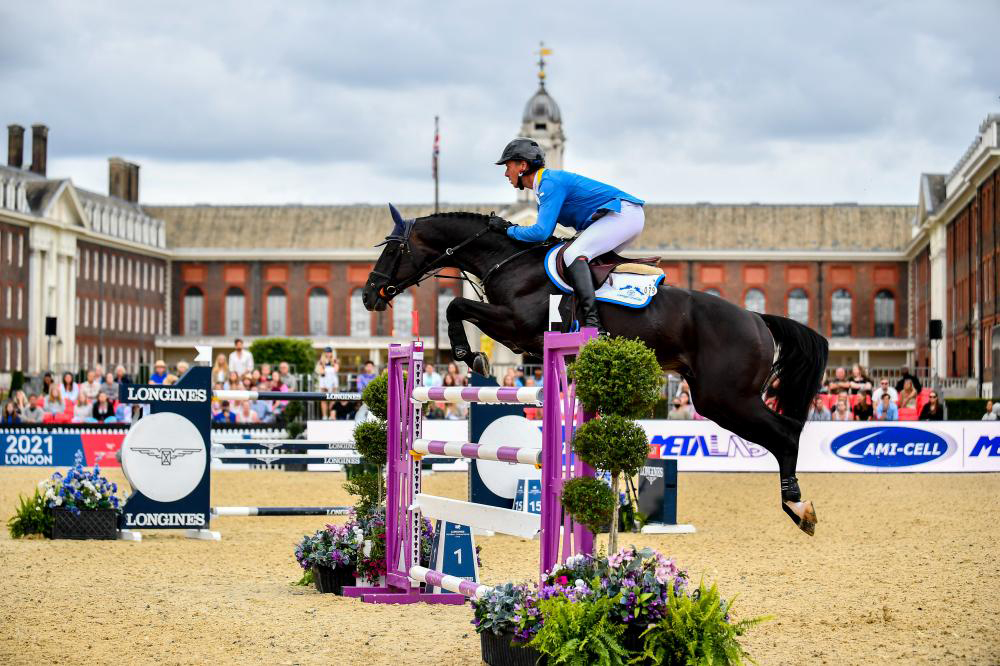
Soilid Gold Z and Christian Ahlmann win the last big class of the 2021 London LGCT – Solid Gold is by Stakkato Gold out of a Calvin Z mare…
“I think we will see that Stakkato and his sons are giving something significant to the international jumping world.”
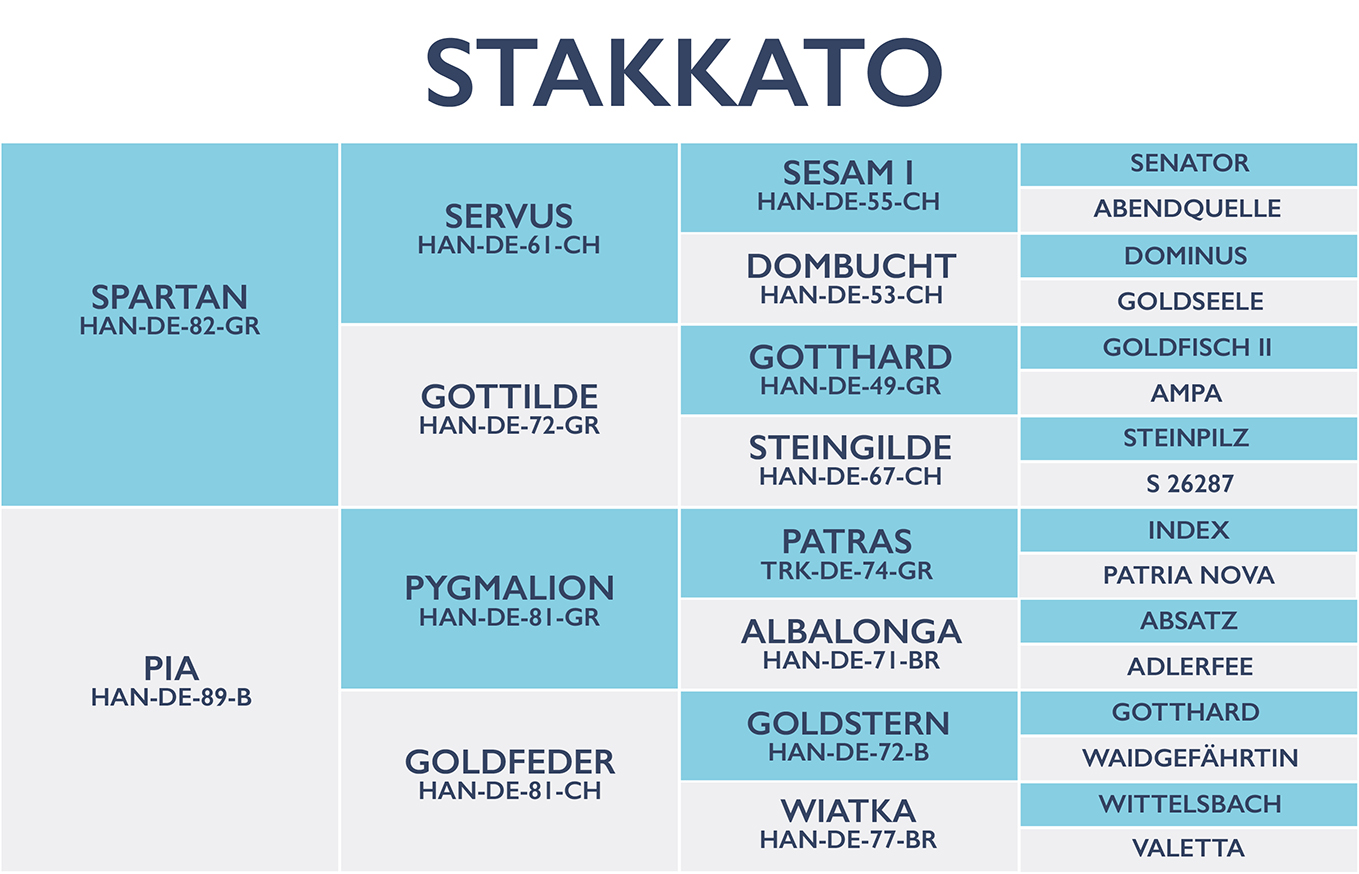



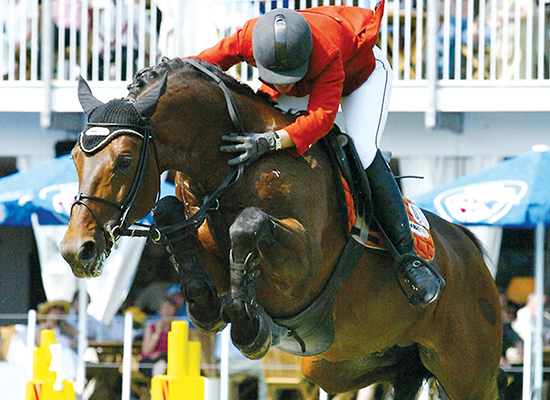
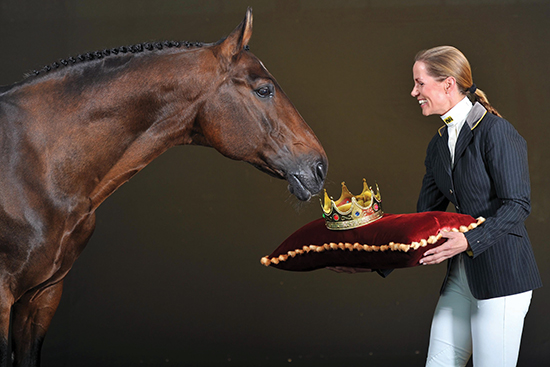
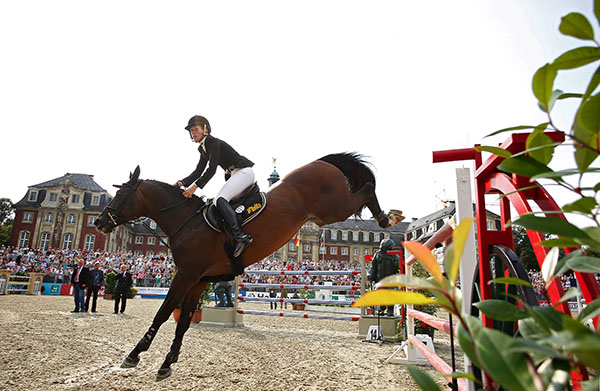
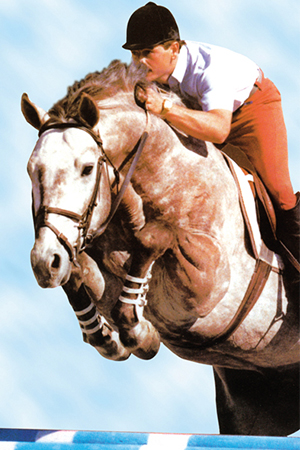
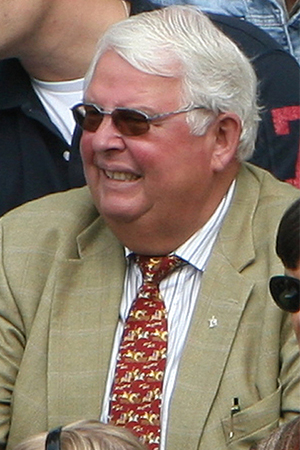
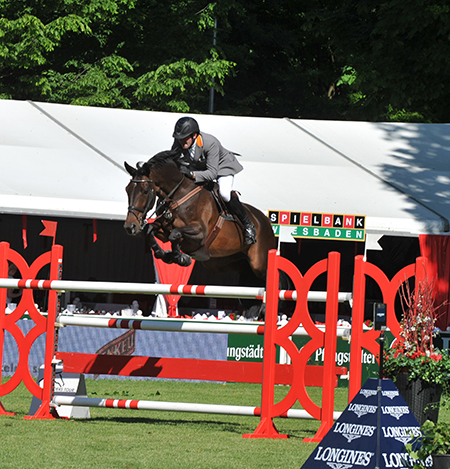
I just want to inform you I still have the only full sister to Stakkato. She is now 14 y and all her sons older then 3 have been approved. I breed every year with her and sell the foals. This year I have 2 Sandro-Boy fillies out of her.
Kind regards
Eric
Is stakkato available to Australian breeders?